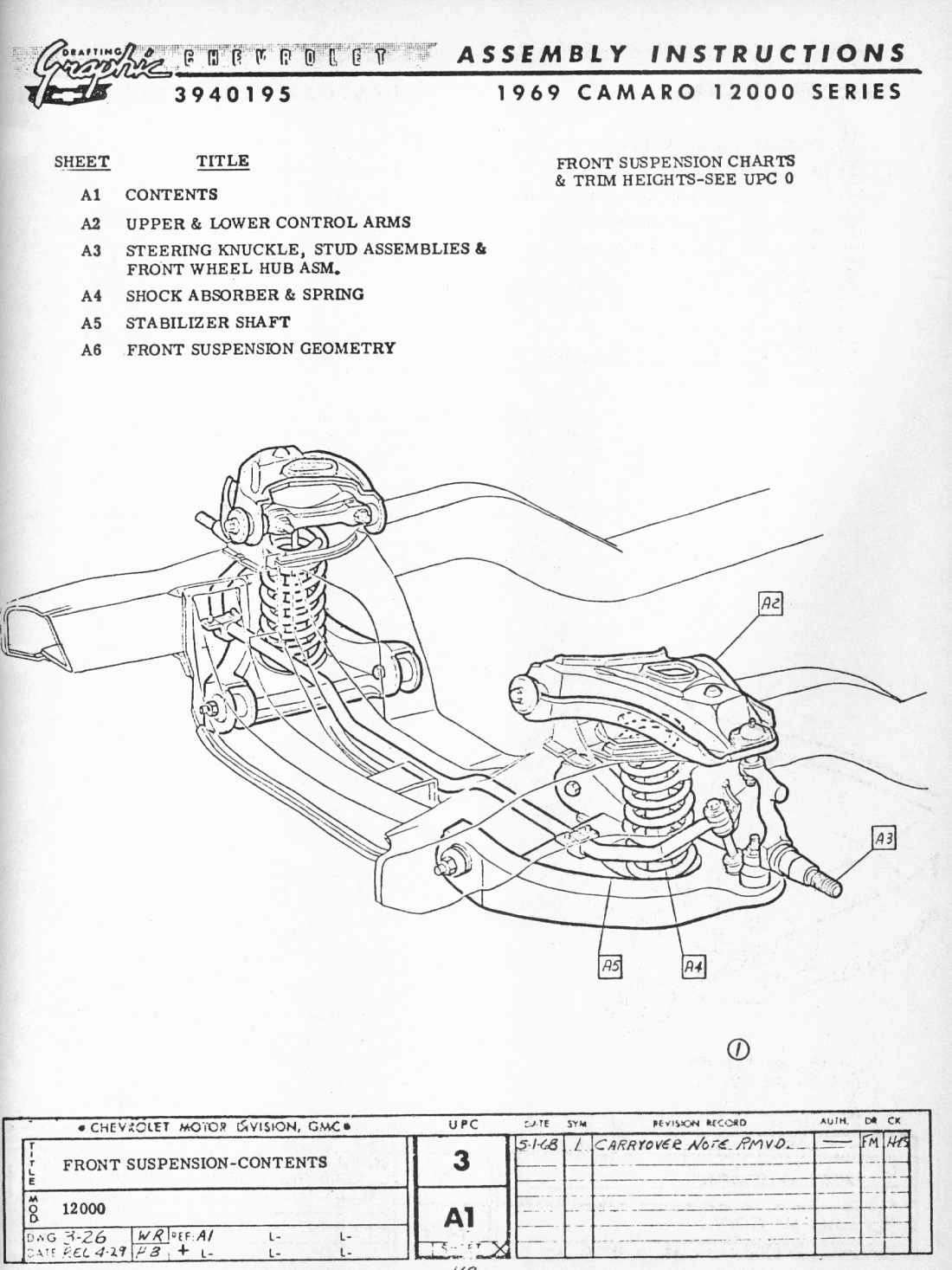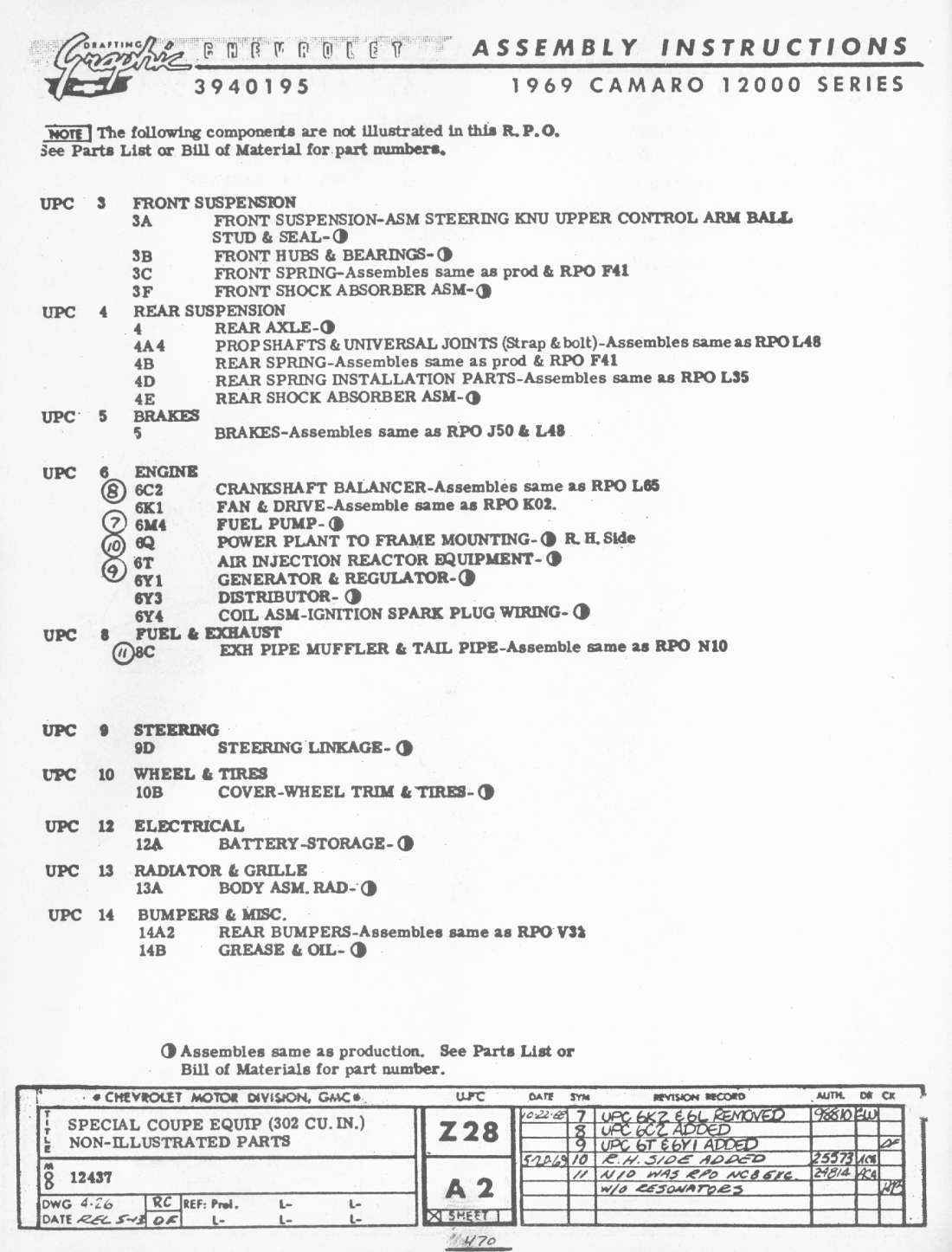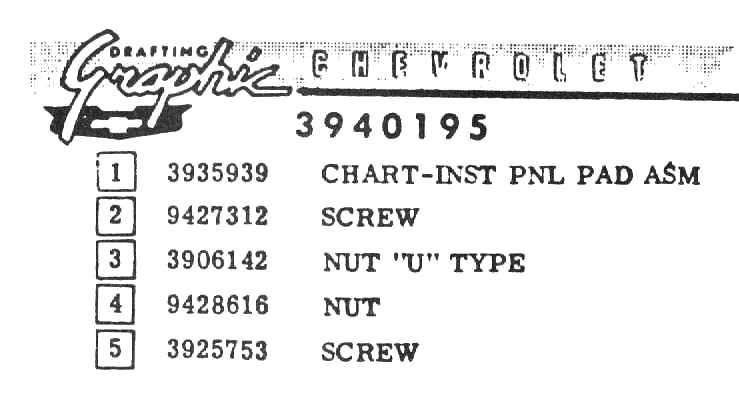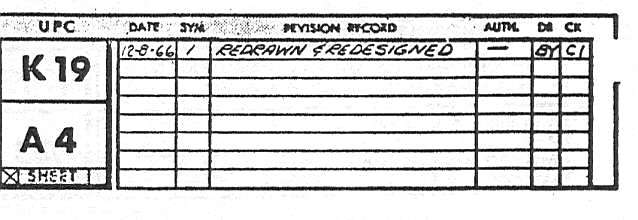CRG Research Report
Understanding the Assembly Manual and Running Changes
© 2010,
Camaro Research Group
Author -
Reviewed by the CRG
Last Edit: 14-Sep-2010
Previous Edits:
Original Release: 14-Sep-2010
|
Index
If you're new to the Camaro hobby or to the various on-line Camaro forums, you've
probably heard or seen the term "A.I.M." tossed around in discussions about what
parts are required or how things are supposed to be assembled. Although it may seem
like just another one of many mysterious acronyms, it's not; it's one of the most
important technical references you can have in your classic Camaro technical library.
What Is The A.I.M.?
"A.I.M." is the abbreviation for "Assembly Instruction Manual",
which was the document supplied to the assembly plant by Chevrolet Engineering as an
assembly aid; it contains graphic illustrations of how all the parts are to be assembled,
all the fasteners and torques, part numbers, special or mandatory assembly sequences,
adhesives, sealers, lubricants, and functional test requirements and processes.
The Assembly Manual covers only Chevrolet-released and installed parts; the body from
the firewall back was built, painted, and trimmed by Fisher Body on their side of the
plant, then shipped to the Chevrolet side, where all the Chevrolet parts were added to
complete final assembly. The comparable Fisher Body assembly information was furnished
to the Fisher plant as a package of Operation Description Sheets, which have never been
published outside of GM.
The Assembly Manual was compiled, published, and distributed by the Chevrolet Engineering
Graphics Department; an "initial issue" complete manual was produced for the beginning of
each new model year, several copies of which were supplied to each assembly plant.
The A.I.M. is a terrific source of graphics and specific Engineering information, but we
need to understand that it was a "living document", frequently revised, and that no
particular reprinted A.I.M. represents any car built at a given point in time. Individual
sheets were revised regularly when new parts replaced existing parts, when parts were
cancelled or removed, when a system was redesigned as a running change, or when illustrations
were revised or updated.
Having spent most of my working career in assembly plants beginning as a Production Foreman
and working my way through the ranks as a General Foreman, Superintendent, Production Manager,
and Plant Manager in numerous Chevrolet (and later, GM Assembly Division, and even later,
Chrysler) assembly plants, I know the Assembly Manual system pretty well, and I thought reviewing
it would be helpful to those not familiar with how to take advantage of this excellent reference source.
This article will explain how the A.I.M. is organized into logical part groupings,
how to recognize changes and dates, and how the A.I.M. was used day-to-day in the plant.
The process that was used for implementing running changes during the production year
and how the Assembly Manual was involved in that system is covered later in this article.
How Is The Manual Organized?
To those who have never worked with the Assembly Manual, it may seem confusing,
which explains the occasional comments I see on-line like "I can't find
anything in that Assembly Manual". GM had an elegantly simple system for organizing the
manual so it aligned with the Engineering releasing procedure which grouped like parts together.
Without getting into the gory detail, the Assembly Manual is separated into two major sections
- the "base car" parts section, and the "option parts" section.
The "Base Car" Section:
The first half of the manual contains only those parts required to
build a "base car" (a car ordered with no extra-cost options - only the standard equipment).
These parts are broken down into systems called "UPC Groups"; UPC is short for "Uniform Parts
Classification" which is the system GM used to classify parts, as follows:
UPC 0: General Information, Vehicle Shipping List, and lubricants, sealers, and adhesives.
UPC 1: Body
UPC 2: Frame
UPC 3: Front Suspension
UPC 4: Rear Suspension and Driveshaft
UPC 5: Brakes
UPC 6: Engine
UPC 7: Transmission and Clutch
UPC 8: Fuel & Exhaust
UPC 9: Steering
UPC 10: Wheels & Tires
UPC 11/13: Front Sheet Metal, Radiator, and Grille
UPC 12: Electrical
UPC 14: Bumpers & Miscellaneous
The UPC Group number is shown in the center of the title block at the bottom of each sheet,
with that group's sheet number directly below it; when referring to a given sheet while
talking or posting to someone else who also has an Assembly Manual, use the UPC number and
Sheet number (i.e., UPC 6, Sheet A3), not the "page number" printed at the top or bottom of
the sheet. The various suppliers who have photocopied various generations of Assembly
Manuals have each "numbered" their version, and the "page numbers" from one supplier's
manual won't be the same as that page in another supplier's manual; the UPC Group number
and sheet number, however, will almost always match.
The "Options" Section:
The second half of the Assembly Manual contains all the parts for
the extra-cost options, and is organized by the RPO (Regular Production Option) sales code
assigned to each option. The RPO codes are a letter and two numbers, like C60 air conditioning,
M20 4-speed transmission, etc.
The options section of the manual is arranged alphabetically by RPO codes; A31 Power Windows
is at the front, U69 Radio at the rear, etc.
GM broke option codes down into like categories as well, by letter, as follows:
A: Body Interior
B: Body Exterior
C: Heating, Ventilation, and Air Conditioning
D: Exterior Ornamentation
F: Suspension
G: Rear Axle
J: Brakes
K: Ignition
L: Engines
M: Transmissions
N: Steering
P: Wheels & Tires
T: Electrical
U: Electrical
V: Electrical
Y: Seat Belts
Z: Special Equipment Packages
How Do I Find Something?
Some UPC and Option sections have many pages; instead of paging through all the sheets
in one section to find a part or assembly, use the "Index Sheet" at the beginning of
each section. This sheet has an illustration and a listing of which parts are on which
sheet in that section (Sheet A2, Sheet B6, etc.).
Typical index sheet at the beginning of a section;
listing at the top shows which sheets in that section cover which specific parts.

|
|
This typical "Non-Illustrated Parts" sheet shows
all the Z/28 parts that have unique part numbers, but assemble the same as the base car
parts; for that reason, these Z/28-unique parts aren't shown in illustrations.

|
|
Why Aren't All The Individual Parts Shown?
Only the parts that were received ready to install at Norwood and Van Nuys are shown in the Assembly
Manual. Individual parts of assemblies (like wheel bearings and races that were part of
front knuckle and rear axle assemblies, etc.) aren't shown, as the assembly plant
didn't deal with them. The best sources of information for items that were part of a
complete assembly are the Chassis Service Manual, the Chassis Overhaul Manual, and the
P&A30 Camaro Parts Book, which show the detail breakdown and cutaway drawings of such assemblies.
Why Aren't All The Option Part Numbers Shown?
In many cases, the sheets for option parts won't show all the specific optional part numbers,
especially if they actually install the same as the similar "base car" part, using the same
fasteners; these are called out with the words "assembles same as production" or with a
half-filled circle symbol on the index sheet at the beginning of the section in the case
where assembly is the same, but there is a long list of part numbers distinguished only
by colors or other characteristics that don't affect the assembly process.
Occasionally you'll find the half-filled circle symbol with a note that says "Assembles same
as production, see Bill of Material for part numbers". The "Bill of Material" is the master
Engineering parts list, with every part number required to build any and all combinations of
cars and options, and has never been available outside of GM.
Example showing the use of a part number for a chart
instead of listing all the different pad part numbers.

|
Similarly, you'll find some parts identified on the sheet not with a part number, but with a
"chart number" instead; this is particularly true of interior trim parts that are physically
identical, but differ only due to color or minor configuration differences. The "chart" was
released by Engineering, and listed the individual part numbers for different configurations
of the same part, depending on the trim combination number or other options.
For instance, there were five different part numbers for 1969 instrument panel pads, and five more
with A/C, distinguished only by color and presence of the A/C center outlet opening; rather
than list all the pad part numbers on the A.I.M. sheet, it just refers to the "chart" part
number. The "chart" information was used on the line to select the correct part number pad
depending on that car's trim color and whether or not it had A/C.
What's All That Stuff At The Bottom Of The Sheet?
The top of the sheet is pretty straightforward - each part number is shown with an item
number reference to the illustration, and if it's a fastener, the little triangle next
to the part number refers to the torque spec at the extreme lower left of the illustration.
Typical title block at the bottom of a sheet
showing UPC and sheet numbers and the revision listing;
the next change will wipe out
the revision history shown, as the revision block is full.

|
The lower portion of the sheet is the "title block", which shows the history of the sheet,
the references from which it was created, and the sheet's revision history.
The left side of the title block shows the title, the model number (12000 series for Camaro),
the date the sheet was completed, the date it was released for publication, the initials of
the illustrator and the checker, and references to other sheets in the same group or to
Engineering Layouts from which the information was taken to create the sheet.
The center of the title block shows the UPC Group and the sheet number within that group.
The right side of the title block is the revision record for the sheet, showing the date,
illustration symbol reference, what was revised, the ECR (Engineering Change Request) number
that authorized the change, and the illustrator and checker who revised the sheet.
The illustration on this sheet has been completely
redrawn, so the
previous revision history has been lost and starts over again.

|
The revision record tells the history of that sheet since its initial release (the date in
the far lower left of the title block); each change is numbered sequentially, and when the
revision block is filled, the next change starts again at the top, with the previous revision
notes eliminated. Occasionally you'll see "Redrawn and Redesigned", which wipes out all previous
sheet history and starts the revision record all over again at that point.
The date of a revision almost never indicates the date the change actually took place on the
line; it just shows when the sheet was revised, which could have been well ahead of or well after
the part change occurred in production at the assembly plant.
Who Used The Manual In The Plant?
The "Master Copy" of the Assembly Manual was kept in the Reliability Supervisor's office, and
was maintained by his Specifications Engineers, who worked directly with plant floor production
supervision and inspectors on quality and specifications issues. Each Production Foreman had an
A.I.M. binder at his desk with only the A.I.M. sheets that affected the operations performed in
his area, and it was kept up to date by the Specifications Engineer assigned to his area. Other
complete copies were used by the Material and Industrial Engineering departments for part tracking
and changes in on-line assembly operations.
When a sheet was revised, the Specs Engineer inserted the new sheet in the Production Foreman's
binder, and threw away the previous sheet; all Production cared about was how to build the car today,
not how it was supposed to be built last month. The Master Copy in the Reliability Office was the
only one that was complete, with all sections, and was kept up to date as revisions occurred.
How Were Running Changes Handled?
Hundreds of part and specification changes were made during the model year, for product
improvements, cost reductions, supplier process changes, assembly improvements, option
package changes, and revisions in standard equipment. Some of the history of these
"running changes" are reflected on the A.I.M. sheets.
When a part or specifications change was desired for Chevrolet-released parts, the
responsible Engineer at Chevrolet Engineering in Warren issued an E.C.R. (Engineering
Change Recommendation) which described the change, the reasons, test requirements, and
desired effective point for the change. Any E.C.R. that affected a Chevrolet plant went
to the Central Office Facilities and Production Planning Department; this group developed
the accompanying Notice of Production Change (N.P.C.) which described how the part change
was to be handled (use up the old parts first or implement the change immediately and
scrap the old parts still in the plant, etc.). The N.P.C. also drove the changes to the
Bill Of Material (which established the flow of material into the plant), and explained
how coordination with other existing or new parts affected by the change were to be handled,
including any Fisher Body changes that had to be in place before the new Chevrolet parts
could be introduced.
Once the N.P.C. details were worked out, that information was forwarded
to Chevrolet Engineering, and the revised Assembly Instruction Manual sheet(s) and the Notice
of Production Change were sent as a package to the affected assembly plant for implementation.
(Depending on the workload in the Graphics department, it was possible that just the N.P.C.
would be forwarded to the plant with the A.I.M. sheet being sent later.)
Now the change has arrived in the mail at the plant - what happens next?
Once the Reliability Group and the Material Control Departments were made aware
that the change was coming, the Specs Man would work with Production to ensure that any required
tooling or fixture changes were identified, designed, and built, that the new material was in
the plant and a fresh Job Study was done by Industrial Engineering to document the detail of the
affected assembly operation time studies, make sure that the Line Inspectors were clued-in so
they knew what to look for, and ensure that the Quality Auditors knew what to look for on completed
cars in Final Inspection.
Once the material, tooling, assembly operators and inspectors were ready, at least one "probe unit"
was run down the line with the change to make sure everything went together as specified; this was
particularly important with a "coordinated change" that affected more than one part. Once the "probe
unit" had been run successfully and any required adjustments had been made, the production change was
finally implemented on the fly, VIN and sequence numbers were recorded to document the exact breakpoint
when the change took place for the records in the Reliability Office and to notify Engineering of the
implementation date, and the new Assembly Instruction Manual sheet was inserted in the foreman's A.I.M.
binder for reference. The previous A.I.M. sheet was thrown in the wastebasket, and was never seen again.
All of this could take quite a while from the date the E.C.R. was written by the release engineer,
the A.I.M. sheet was revised in the Engineering Graphics Department, the N.P.C. was developed at
Production Planning, the part change activity was completed at the supplier, the N.P.C. and new A.I.M.
sheet were distributed by Engineering to the plant, the assembly plant planning and tryout activity was
done, to the actual change incorporation date on the line. This was more likely to be measured in months
than in weeks from the date the A.I.M. sheet was revised, particularly with a "coordinated change".
It's highly unlikely that any of the reprinted A.I.M.'s from the various current suppliers of
them represent a car as built at any particular point in time due to the complex procedures
outlined above. Even if they got
a "Current Master" on the last day of production for a particular model year, there would be lots of
sheets in it that showed changes that had not yet been implemented. There was no end-of-model-year
"Final Edition" of any A.I.M.; they were "living documents" that were continually added to during the
model year, and when the model year was done, so were the Manuals, minus all the old discarded revised
sheets that had been superseded.
A lot of administrative complexity (necessary to keep a complex business like Chevrolet running
that built nearly 20,000 different cars and trucks every day), but as Camaro hobbyists,
we're extremely fortunate to have the resultant Assembly Instruction Manual documentation available.
We have them as formal documents for every model year from 1956-up; our fellow Ford and Mopar enthusiasts have
literally ZERO factory documentation to work with, and they'd LOVE to have anything like our Assembly Manuals.
Acknowledgements
Thanks to Art Armstrong, who also worked at Chevrolet Engineering in those days, for his insights
and comments which helped wake up some sleeping brain cells as I recalled "the good old days on the line"
for this article.



